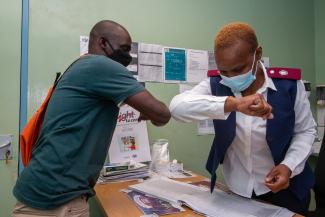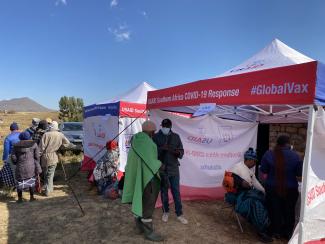SOUTH AFRICA BILATERAL HEALTH PROGRAM
Through the President’s Emergency Plan for AIDS Relief (PEPFAR), USAID works closely with other U.S. government agencies to support host governments in controlling the spread of HIV and AIDS and related diseases. South Africa has the largest PEPFAR portfolio in the world. USAID support includes overseeing a complex and comprehensive portfolio of HIV prevention, care, and treatment, health systems strengthening, and strategic information, and works to strengthen the country’s health systems and improve health outcomes for all.
USAID uses an integrated and evidence-based approach to partner with the Government of South Africa, private sector, academia, civil society, and communities to improve health outcomes for all. This partnership is guided by South Africa’s 2023-2028 National Strategic Plan for HIV, TB, and Sexually Transmitted Infections (NSP). Over 80 percent of partners are locally based organizations and include new Government-to-Government partnerships with the national Departments of Social Development and Basic Education. New partnerships with provincial health departments are in progress to support local ownership and enhance sustainability.
SOUTHERN AFRICA REGIONAL HEALTH PROGRAM
USAID’s Regional Health Office (RHO) works with PEPFAR teams across Sub-Saharan African countries to mitigate the impact of the HIV/AIDS epidemic and improve health outcomes for Southern Africans.
The decrease in new HIV infections in eastern and southern Africa since 2010 is larger than in any other region. The region is closing in on the 90–90–90 testing and treatment targets. Seven countries have reached those Fast-Track Targets (Botswana, Eswatini, Lesotho, Namibia, Rwanda, Uganda, Zambia, and Zimbabwe), and others are very close to doing so.
Five of these countries, Botswana, Eswatini, Lesotho, Namibia, Zambia, and Zimbabwe fall within the southern Africa region are directly served by the Regional Health Office. Despite this considerable progress, according to UNAIDS there is still a need to reduce the incidence of new infections among women, and the incidence of HIV infections among adolescent girls and young women (aged 15 to 24 years). There is also a need to increase the percentage of children who are virally suppressed. Finally, there is a need to further reduce the number of deaths due to HIV and AIDS, Tuberculosis, and pandemics such as COVID 19.



